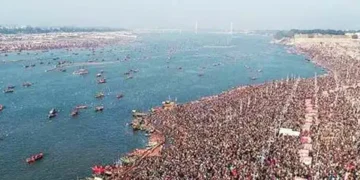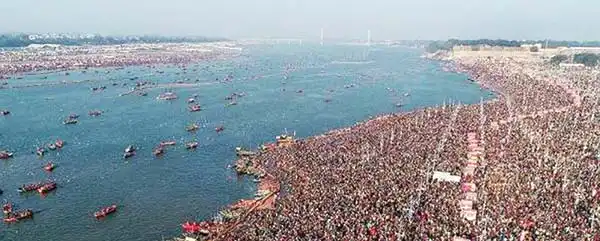Blitz Bureau
THE Maha Kumbh Mela, celebrated as the world’s largest spiritual gathering, is a breathtaking convergence of faith, culture, and ancient tradition.
Rooted in Hindu mythology, this sacred festival unfolds four times over a course of twelve years, rotating between four revered cities in India: Haridwar, Ujjain, Nashik, and Prayagraj. Each of these cities is situated along the banks of the holiest rivers— the Ganges, Shipra, Godavari, and the confluence of the Ganges, Yamuna, and the mythical Sarasvati. In 2025, from January 13 to February 26, Prayagraj will once again become the heart of this magnificent celebration, drawing millions of pilgrims and visitors to witness a profound display of devotion, unity, and the vibrant expression of India’s spiritual heritage.
This grand event transcends religious practices, encompassing a rich blend of astronomy, astrology, sociocultural traditions, and spiritual enlightenment. Millions of devotees, ascetics, and seekers gather to partake in the sacred rituals, including the holy bath at the Triveni Sangam, believing it to cleanse their sins and lead them toward spiritual liberation.
Key rituals, practices Shahi Snan: The Maha Kumbh Mela is a grand assembly of rituals, with the bathing ceremony standing as the most significant of them all. Held at the Triveni Sangam, millions of pilgrims gather to partake in this sacred practice, which is deeply rooted in the belief that immersing oneself in the holy waters can cleanse an individual of all sins. This act of purification is believed to liberate both the individual and their ancestors from the cycle of rebirth, ultimately leading to Moksha, or spiritual liberation.
Alongside the bathing ritual, pilgrims also engage in worship along the banks of the sacred river and participate in enlightening discourses led by sadhus and saints, adding a layer of spiritual depth to the experience. Aarti: The Ganga Aarti ceremony on the riverbanks is an unforgettable sight for the participants. During this sacred ritual, priests perform intricate ceremonies while holding glowing lamps, offering a visual spectacle.
Kalpavas: A profound yet lesserknown aspect of the Maha Kumbh Mela, Kalpavas offers seekers a sacred retreat dedicated to spiritual discipline, austerity, and higher consciousness. Prayers, offerings: Devotees perform Dev Pujan to honor deities believed to visit the Sangam during the Kumbh. Rituals such as Shraadh (offering food and prayers to ancestors) and Veeni Daan (offering hair to the Ganges) are integral to the festival, symbolising surrender and purification.
Deep daan: During the Kumbh Mela in Prayagraj, the ritual of Deep Daan transforms the sacred rivers into a mesmerising spectacle. Devotees float thousands of lighted earthen lamps (Diyas) on the flowing waters of the Triveni Sangam as an offering of gratitude.
Parikrama: The historical ritual of circumambulating Prayagraj has been revived to reconnect pilgrims with ancient practices. This journey encompasses sacred landmarks, offering spiritual fulfilment while preserving cultural heritage.






























